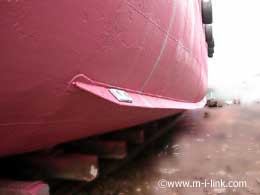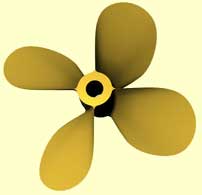

The Useful Death of the MV Galveston
by Captain Tom Crichton (Edited by T. Horodysky)
In World War II the death of a merchant ship was usually as swift and final as a massive coronary. But the MV Galveston, a unique and contrary vessel in many ways, got sick during the terrible winter of 1943-4 but did not breathe her last until she arrived at Omaha Beach on June 7, 1944.
At her launching in 1921, MV Galveston was the largest American vessel to be fitted with a diesel motor. But no one was very happy with her. For reasons of their own, American marine engineers took an instant dislike to “firecrackers” and tried to avoid them. She was one-of-a-kind until the C1-M “knot ships” were built late in the war.
The Galveston was a convoy commodore’s nightmare. When he called for two-knots, the Galveston could not do it. A "firecracker" doesn't have pistons which can be pushed lazily up and down. Four knots was her absolute minimum. So she ran ahead till she nearly bumped the ship forward, and then had to stop until a trailing vessel was about to ram her.
It took only a few such maneuvers to exhaust the supply of starting air. Then she had to straggle until auxiliaries could replenish the air tanks. Each time she was restarted, she threw a dense cloud of soot into the air as most diesels do.
Voyage 47, her longest and her last, began at New Orleans on Feb. 3, 1944, where she loaded “full and down” for Great Britain. She was convoyed without incident to New York, then Halifax. Her next convoy, comprised 110 merchant vessels and 20 shepherds of the Royal Canadian Navy. This armada covered 20 square miles of ocean.
The Galveston, causing trouble as always, was positioned at the end of a column. All went well until just after midnight on day 6 when the convoy was 800 miles east of Newfoundland.
Suddenly everyone on board felt an upward pressure of the type we experienced when depth charges detonated nearby. We listed slightly to port and then heard a strange metallic squealing for a few seconds, followed by a violent crash. Next was an unceasing bucking as though we were mounted on a rodeo bronco. We thought we had been torpedoed.
No one will ever come up with a precise answer as to what occurred. Later, we saw that the starboard bilge keel from about the turn of the bow all the way aft had been folded right up against the hull plates. It was polished bright and thus accounted for the squealing. We accounted for the rodeo ride by the fact that two consecutive bronze blades of the four-bladed built up propeller had been sheared right off.
 |
 |
| Bilge keel, a fin or long strip of plate attached to the turn of the bilge and running from 25% to 75% of ship's length at both sides of a ship's underside; bilge keels serve to reduce the rolling motion at sea | Example of a 4 blade propeller |
We concluded that a German U-boat had attempted to surface astern of our convoy, and thought that the water above him was clear, but the Galveston was out of position -- well astern of its column. The force of two very strong blades could easily have punctured his hull and, as there was no attack at dawn, we believed his boat foundered with all hands. [Editor: they were not credited with a sinking]
Galveston could hold out only until daylight with its two-bladed propeller. We were already far astern of the convoy when a Canadian Corvette approached to Investigate. When we blinked that we could not even sustain 7 knots, he ordered us to turn back for St Johns, Newfoundland. There was a touching ceremony. The Canadian was evidently an old-fashioned gent of the sea. He came as close as possible and fired a line on board. Then he attached a bottle of whiskey with a note attached.
The whiskey didn’t quite make it -- a sudden lurch of both vessels smashed it against our sides -- but the note did. “The Royal Canadian Navy wishes you good luck and God’s speed.” Thankfully nobody sang “Nearer My God to Thee” We had the good luck, as it turned out, but we did not have God’s speed.
St Johns was mostly a fishing port with modest repair facilities, and the ancient coal-burning tug, Foundation Aranmour, towed us to Halifax. New propellers to fit were not available, so the surviving two blades were placed opposite each other to create some sort of balance, and two scrapyard blades were added. This curious jury propeller worked well enough to allow us to join the next convoy for the British Isles.
Exactly half way across the North Atlantic, her freak propeller went awry. Six knots was the absolute limit the machinery would stand, and again we had to bid farewell to the convoy. No whiskey, no note and no St Johns' this time. Our exasperated commodore ordered us to sail a rhumb line for the Irish Sea and then disappeared over the horizon with his flock.
But luck was on our side and we did not encounter the enemy. We dry-docked at Swansea, and discovered the Galveston had lost one of her original blades. Local scrap yards could not come near matching any of our blades, but the next best thing was attached. It mattered less this time because the Galveston would never again be asked to sustain more than 5 knots.
After complete discharging operations, a gang of locusts set to work on our ship. Away went all her booms, heavy lift rigging and even her ten electric cargo winches which had been the vessel’s most advanced feature. We received better armament and a barrage balloon and had to attend school to find out what to do with it. Then, we limped to a safe anchorage off the delightful Scottish resort of Oban.
For three long weeks we heard no evil, saw no evil and spoke not a word to anyone. We were forbidden to go ashore, and when additional very dilapidated vessels of various flags anchored nearby, we were forbidden to speak them. Then one day a distinguished looking Royal Naval party swung on board carrying great blocks of dynamite. Every man on board concluded that this visit was going to do the Galveston no eventual good.
A few days prior to D-Day we were told to head for a rendezvous point off Poole on the British Channel, each vessel to plot a course at its own discretion. My last job before we departed was to paint a piece of spare canvas with the four-foot figures “456” for prominent display on the house beneath the bridge. On the night of June 5th, 52 ships of the greatest assortment were trying to keep some sort of order under way in a wild gale.
The great invasion of Normandy should have commenced at 0500 that morning, but due to the weather, General Eisenhower called for a delay. We were ordered to find such shelter as we could beneath the cliffs around Bournemouth. On June 6, we raised anchor for the short run to Omaha Beach. Four thousand vessels were trying to dodge each other in those tight waters, and that is where I made the worst mistake of my career.
A distinct convoy approached ours at an angle from our port side and ran right through us. In the melee I became totally confused and slipped into the wrong convoy, which was headed for Utah Beach. That is where we arrived on the morning of June 7 in the company of landing craft and transports. The combat craft knew just what to do, but nobody on the Galveston had any idea of what was going on.
An hour later wild radio messages were being sent all over the front “Has anybody seen the Galveston? She is wanted at Omaha Beach.”
We had to steam close on-shore past all the German positions that were still intact and fighting, but they never shot at us.
When our “456” was sighted at Omaha, the angriest New Yorker I have ever met swung on board with a, “Goddam it, where have you been? You’ve held up the entire operation.” Half the New York Bar Pilots Association had been sent to the invasion front expressly to position the block ships. Galveston had been honored to be one of two “gate ships” that would form the entrance to the artificial harbor. The other was the Sumatra, a formerly proud battle cruiser from the Netherlands Navy. Battered in battle and stripped of all her armament, this gallant lady looked worse than we did.
Tugs took charge fore and aft. “Finished With Engines” and “Abandon ship,” and the whole merchant crew went down scrambling nets onto a small craft, leaving the Navy gun crew behind. No sooner were we away than entire hull plates flew off the unfortunate Galveston. The master saboteur at Oban had placed his dynamite well, and the vessel was resting on the bottom exactly at deck level in ten seconds.
German gunners in safe inland positions were peppering “Operation Mulberry” with their dreaded 88 mm. guns and creating havoc. A tug sank very close to us, and the coxswain of a landing craft was decapitated. All Galveston’s people were safely taken to LST 502 which had discharged her armor and was loading wounded GIs for evacuation. All of us became hospital orderlies carrying food and bedpans on the vessel’s tank deck.
For the remainder of the afternoon we could see other derelicts being scuttled to complete the artificial sea wall which was to prove invaluable to operations at this most terrible of the five invasion beaches. The sacrificed ships, pinned down by sand and rock ballast, remained steadfast through the storm that scattered the Mulberries. Supply officers have credited our operation with being the salvation of the entire invasion, for until Cherbourg fell, the artificial harbor at Omaha Beach was the gateway to the Normandy campaign.
The saga of the Galveston’s crew ended comically. We set ashore in England and then loaded into cattle trucks. Heavily armed motorcycle escorts led the parade with sirens wailing, and every Englishman along the road could only conclude that the weary and badly dressed men in cattle trucks must be captured Germans. Hence every inch of the drive we were hooted and booed at, and shown angry fists or V-for Victory signs.
It was nothing new. Throughout World War II, U.S. Merchant seamen were insulted and called draft-dodgers by armed forces personnel who never left Staten Island during the entire war.
Sources:
AMMV News, 1996 #3
http://boatdesign.net
http://www.m-i-link.comAmerican Merchant Marine at Normandy June 1944
06/04/04